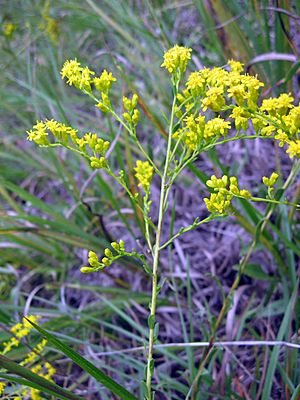Solidago gattingeri facts for kids
Quick facts for kids Solidago gattingeri |
|
|---|---|
 |
|
| Conservation status | |
| Scientific classification | |
| Genus: |
Solidago
|
| Species: |
gattingeri
|
| Synonyms | |
|
Aster gattingeri (Chapm. ex A. Gray) Kuntze |
|
Gattinger's goldenrod (Solidago gattingeri) is a special plant known for its bright yellow flowers. It is a type of goldenrod, which are common wildflowers. This specific goldenrod is quite rare because it only grows naturally in a few places in the United States. You can find it in the Ozark Mountains of Arkansas and Missouri, and in the Nashville Basin of Tennessee.
Contents
All About Gattinger's Goldenrod
Where Gattinger's Goldenrod Lives
Gattinger's goldenrod loves to grow in dry, rocky areas. Its favorite spots are places called cedar glades or cedar barrens. These are open areas with thin soil over limestone rock. It also grows on limestone outcrops, which are places where the limestone rock sticks out of the ground. These habitats are often very dry, but the plant is well-suited to them.
What Gattinger's Goldenrod Looks Like
Gattinger's goldenrod is a perennial plant. This means it lives for more than two years, coming back to life each spring. It produces many small, yellow flowers in late summer. A single plant can have as many as 250 flower heads! Some of these flowers grow in large groups at the very top of the plant. Others appear in smaller bunches on the side branches.
How It's Different From Other Goldenrods
There are many types of goldenrods, and Gattinger's goldenrod has some unique features that help tell it apart.
- It has fewer flowers on each head compared to a similar plant called Solidago juncea.
- It is also related to Solidago missouriensis. But Gattinger's goldenrod has leaves near the top that look a bit like small, thin leaves called bracts. It also has shorter underground stems, known as rhizomes.


